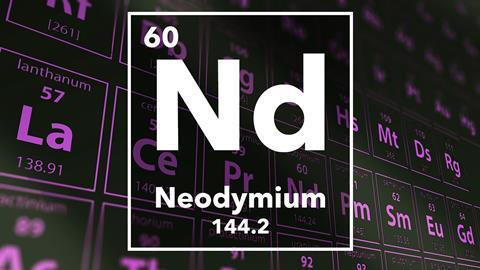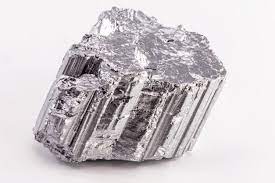Identity.
Neodymium (Nd), atomic number 60, might not sound glamorous, but this
rare-earth metal punches above its weight. Imagine a silvery metal,
highly reactive and rarely seen alone. Yet, when alloyed with iron and
boron, it transforms into the world's strongest permanent magnet,
powering countless technologies from wind turbines to your headphones.
It also adds vibrant purple hues to glass and even contributes to the
blue in some lasers. Humble neodymium – a hidden powerhouse shaping
our world in surprising ways.
Atomic Structure:
The nucleus consists of 60 protons (red) and 82 neutrons (blue). 60
electrons (green) bind to the nucleus, successively occupying
available electron shells (rings). Neodymium is a lanthanide in period
6, and the f-block of the periodic table. It melts at 1024 degrees
Celsius.
History.
Neodymium's story doesn't begin with its own discovery, but with a
twist. In 1839, Carl Gustav Mosander isolated "didymium," thinking it
a single element. It took decades to unravel the truth. The first clue
came in 1879 when samarium was separated from didymium. A year later,
gadolinium followed. Finally, in 1885, Austrian chemist Carl Auer von
Welsbach used spectroscopy to reveal didymium's true nature: it was
two elements masquerading as one! He named them "neodymium" (new twin)
and "praseodymium" (green twin).
While initially confined to the lab, neodymium's potential started
to shine. In 1927, its unique optical properties made it a popular
glass dye, coloring everything from welding goggles to sunglasses.
Its magnetic potential was also unlocked, leading to the
development of the first neodymium magnet in the 1930s.
The true power of neodymium magnets wouldn't be realized until the
1980s, when breakthroughs in sintering technology created the
super-strong magnets we know today. This revolutionized countless
industries, from electronics to energy, cementing neodymium's
place as a hidden force shaping our modern world. Its journey,
however, continues, with ongoing research exploring its potential
in clean energy, medical applications, and even space exploration.
Usage.
While neodymium shines brightest in its role as the powerhouse behind
the strongest permanent magnets, its talents extend far beyond. It
adds vibrant purple hues to glass, making it a hidden ingredient in
welding goggles and tanning booths. Neodymium even contributes to the
blue you see in lasers and sunglasses! But don't underestimate its
future potential - research explores its use in sustainable lighting,
cleaner chemical reactions, and even medical treatments, making
neodymium a versatile star with plenty of surprises left to reveal.
-
Magnetic MarvelNeodymium's claim to fame lies in its
unmatched magnetism. When alloyed with iron and boron, it creates
neodymium magnets, the strongest permanent magnets available.
These tiny titans drive a vast array of technologies, from the
hard drives in your computer to the wind turbines generating clean
energy. They power electric motors in everything from EVs to
high-speed trains, and even make your child's toy train sets zoom
around the tracks.
-
Colorful Chameleon: Don't underestimate neodymium's
aesthetic side! Adding it to glass unleashes stunning shades of
violet, wine-red, and grey. These captivating colors adorn welding
goggles, protecting your eyes from intense light, and even add a
touch of flair to tanning booths. Neodymium also contributes to
the vibrant blue we see in some lasers and sunglasses, making it a
hidden ingredient in everyday beauty.
-
Beyond the Obvious:Neodymium's potential extends far beyond
its current applications. Researchers are exploring its use in
developing energy-efficient lighting solutions, cleaner and more
efficient chemical reactions through catalysts, and even medical
treatments with unique properties. While ethical sourcing remains
a crucial concern, neodymium's versatility promises exciting
possibilities for the future, from cleaner technologies to
groundbreaking medical advancements.
Some of the benefits of using Neodymium are:
-
Thanks to their incredible strength, neodymium magnets enable
smaller and lighter designs in various devices. This translates to
significant efficiency gains. For example, smaller electric motors
in wind turbines and EVs require less energy, reducing overall
consumption and contributing to a greener future.
-
Neodymium's ability to generate highly focused magnetic fields
makes it ideal for applications requiring fine control. In medical
equipment like MRI machines, its precise field strength allows for
detailed diagnostics and targeted therapies. It also powers
high-tech actuators in robots and automation, enabling precise
movements and delicate tasks.
-
While neodymium requires responsible sourcing, its use can promote
sustainability. For example, neodymium magnets help create
smaller, more efficient electric motors, leading to energy
savings. Research also explores its application in developing
energy-efficient lighting solutions and catalysts for cleaner
chemical reactions.
-
Neodymium's potential extends beyond current applications.
Researchers are exploring its use in various fields, including
developing medical treatments with unique properties. Imagine
treatments for pain management, wound healing, or even improved
diagnostic tools – all powered by the hidden potential of
neodymium.
Sources.
While not abundant, neodymium hides in plain sight. Its primary
sources are minerals like monazite and bastnäsite, found in various
locations worldwide. China currently dominates neodymium production,
but other countries like Brazil, Vietnam, and the United States also
hold significant reserves. Responsible sourcing and exploration of
alternative sources are crucial to meet the growing demand for this
versatile element.
Properties.
Magnetic Marvel: Neodymium holds the title for the strongest
permanent magnets. When combined with iron and boron, it forms
neodymium magnets, driving everything from wind turbines and hard
drives to electric vehicles and MRI machines. This incredible strength
allows for miniaturization and efficiency gains in various
technologies.
Color Chameleon: Don't let its metallic appearance fool you!
Neodymium possesses unique optical properties. Adding it to glass
unlocks a spectrum of stunning purples, wine-reds, and grays. These
captivating colors find their way into welding goggles, sunglasses,
and even artistic sculptures. Neodymium even contributes to the
vibrant blue seen in some lasers, playing a hidden role in our
everyday visuals.
Reactivity with Potential:Despite its relative stability,
neodymium possesses significant reactivity, opening doors for diverse
applications. Researchers are exploring its use in developing
energy-efficient lighting solutions, catalysts for cleaner chemical
reactions, and even medical treatments with unique properties. Its
potential extends beyond current uses, offering exciting possibilities
for a sustainable and innovative future.

